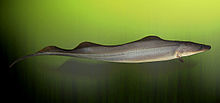Gymnarchus
| Gymnarchus niloticus | |
|---|---|

| |
| Gymnarchus swims with its back straight, detecting prey by the way they distort the electric field it generates. | |
| Scientific classification | |
| Domain: | Eukaryota |
| Kingdom: | Animalia |
| Phylum: | Chordata |
| Class: | Actinopterygii |
| Order: | Osteoglossiformes |
| Suborder: | Notopteroidei |
| Family: | Gymnarchidae Bleeker, 1859 |
| Genus: | Gymnarchus Cuvier, 1829 |
| Species: | G. niloticus
|
| Binomial name | |
| Gymnarchus niloticus Cuvier, 1829
| |
Gymnarchus niloticus – commonly known as the aba, aba aba, frankfish, freshwater rat-tail, poisson-cheval, or African knifefish – is an electric fish, and the only species in the genus Gymnarchus and the family Gymnarchidae within the order Osteoglossiformes. It is found in swamps, lakes and rivers in the Nile, Turkana, Chad, Niger, Volta, Senegal, and Gambia basins.[1][2]
Description and biology[edit]
G. niloticus has a long and slender body, with no caudal, pelvic, or anal fins. The dorsal fin is elongated, running along the back of the fish towards the blunt, finless tail, and is the main source of propulsion. It grows up to 1.6 m (5.2 ft) in length and 19 kg (42 lb) in weight.[3]
G. niloticus is nocturnal and has a poor vision. Instead, it navigates and hunts smaller fish using a weak electric field, as demonstrated by the zoologist Hans Lissmann in 1950, when he noticed that it could swim equally well forwards or backwards, clearly relying on a sense other than vision. This opened up research into electroreception and electrogenesis in fish.[4] Like the related elephantfish, which hunts the same way, it possesses an unusually large brain, which is believed to help it interpret the electrical signals.[3] It makes its tail negatively charged with respect to its head. This produces a symmetrical electric field around its body, provided it keeps its back straight; it does this by swimming using its fins. Nearby objects distort this field, and it can sense the distortion on its skin.[5]
G. niloticus females lay their eggs in floating nests up to 1 m (3.3 ft) across. The adults continue to guard the young after hatching.[3] The sperm cells lack a flagellum, moving like an amoeba instead.[6]
References[edit]
- ^ a b Lalèyè, P.; Azeroual, A.; Entsua-Mensah, M.; Getahun, A.; Moelants, T.; Vreven, E. (2020). "Gymnarchus niloticus". IUCN Red List of Threatened Species. 2020: e.T181688A134949091. doi:10.2305/IUCN.UK.2020-2.RLTS.T181688A134949091.en. Retrieved 23 December 2023.
- ^ Froese, Rainer; Pauly, Daniel (eds.) (2014). "Gymnarchus niloticus" in FishBase. April 2014 version.
- ^ a b c Greenwood, P. H.; Wilson, M. V. (1998). Paxton, J. R.; Eschmeyer, W. N. (eds.). Encyclopedia of Fishes. San Diego: Academic Press. p. 84. ISBN 0-12-547665-5.
- ^ Lissmann, Hans. "Continuous Electrical Signals from the Tail of a Fish, Gymnarchus Niloticus Cuv", in: Nature, 167, 4240 (1951), pp. 201–202.
- "The Mechanism of Object Location in Gymnarchus Niloticus and Similar Fish", in: Journal of Experimental Biology, 35 (1958), pp. 451–486. (with Ken E. Machin)
- "The Mode of Operation of the Electric Receptors in Gymnarchus Niloticus", in: Journal of Experimental Biology 37:4 (1960), pp. 801–811. (with Ken E. Machin)
- "Electric Location by Fishes", in: Scientific American, 208, pp 50–59, March 1963.
- ^ Alexander, R. McNeill (2006). "A new sense for muddy water". Journal of Experimental Biology. 2006 209 (2): 200–201. doi:10.1242/jeb.10.1242/jeb.02012. PMID 16391343.
- ^ Kunz, Yvette W. (2004). Developmental Biology of Teleost Fishes. Fish & Fisheries. Springer. p. 143. ISBN 978-1-4020-2996-7.

